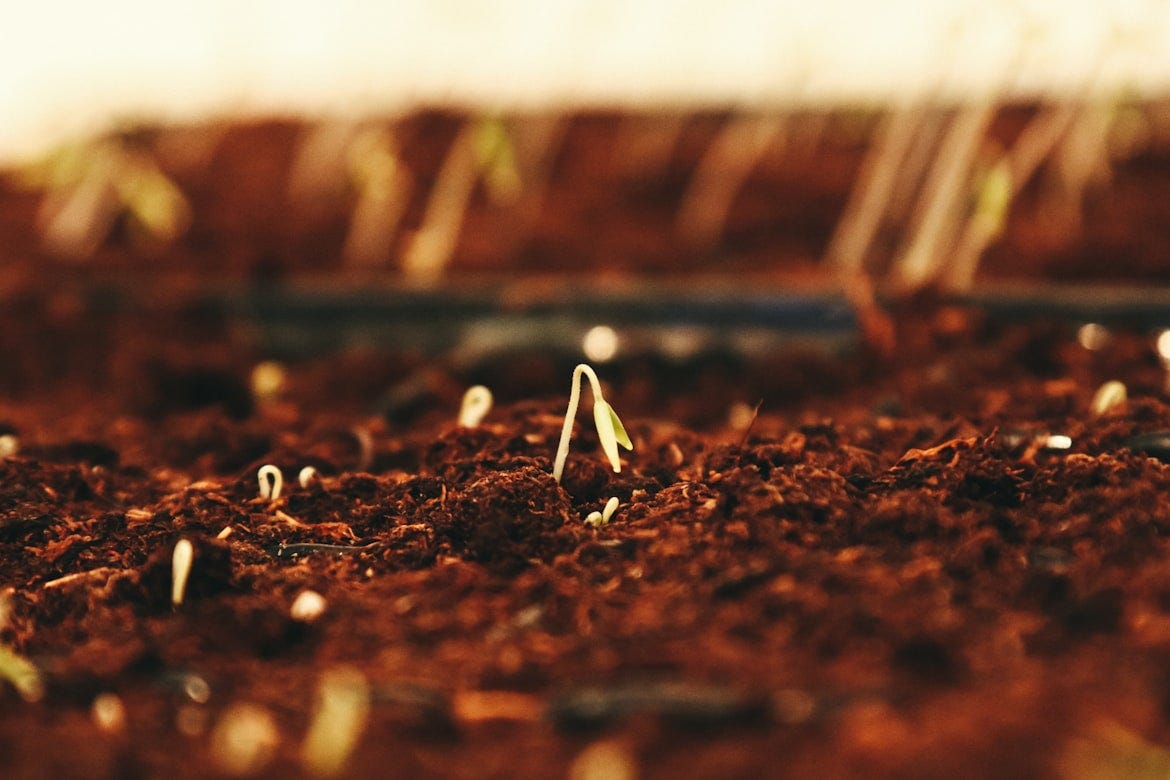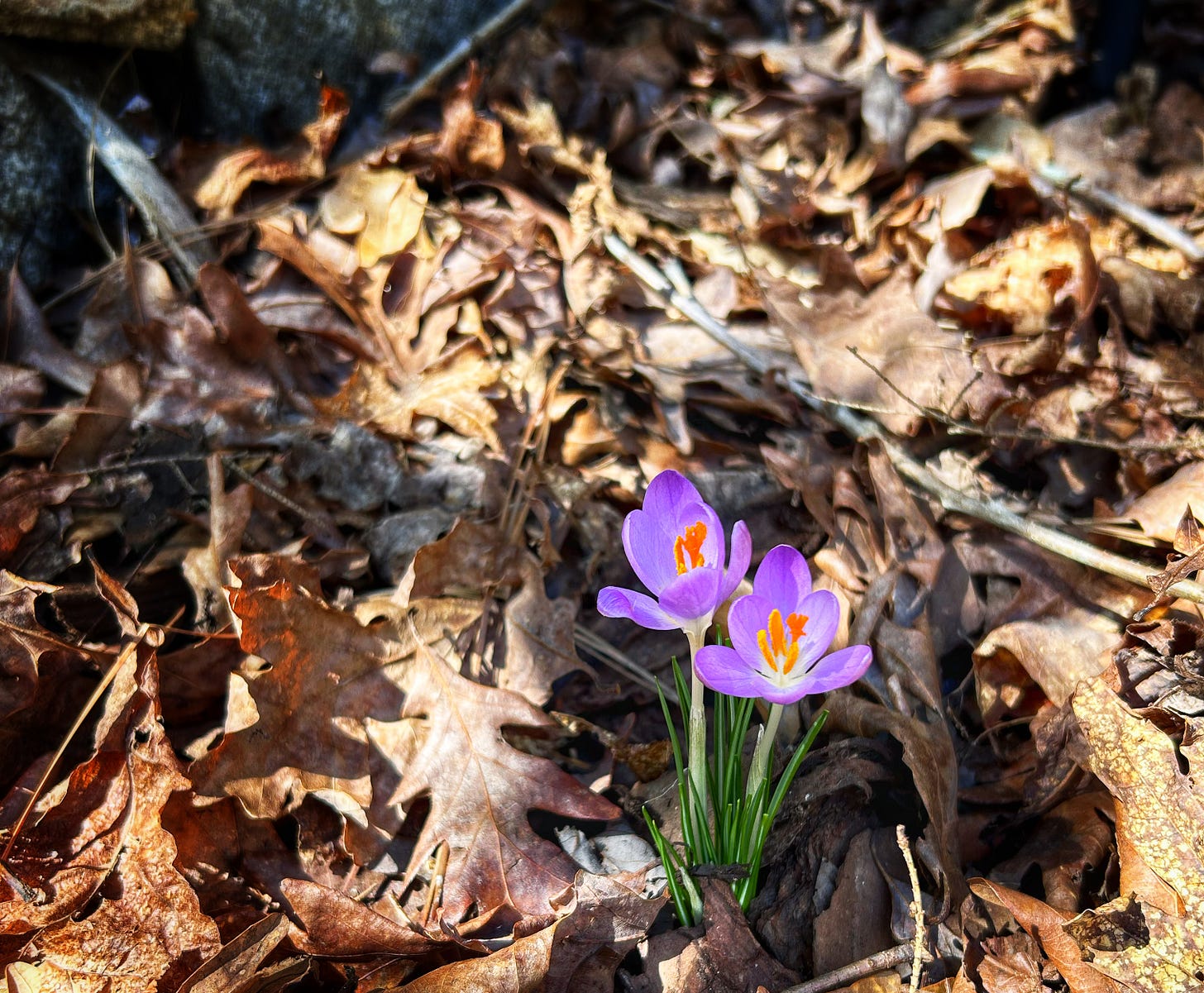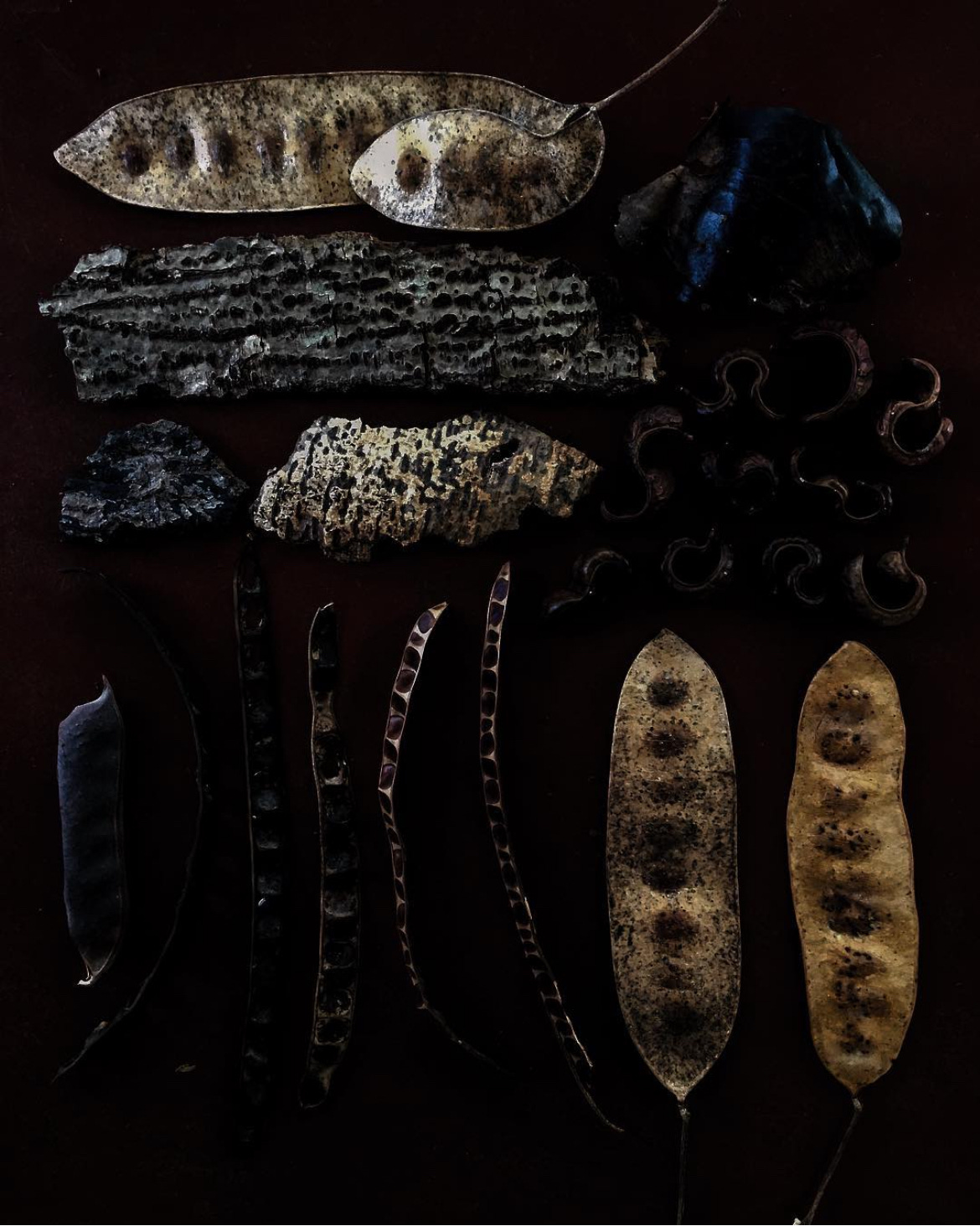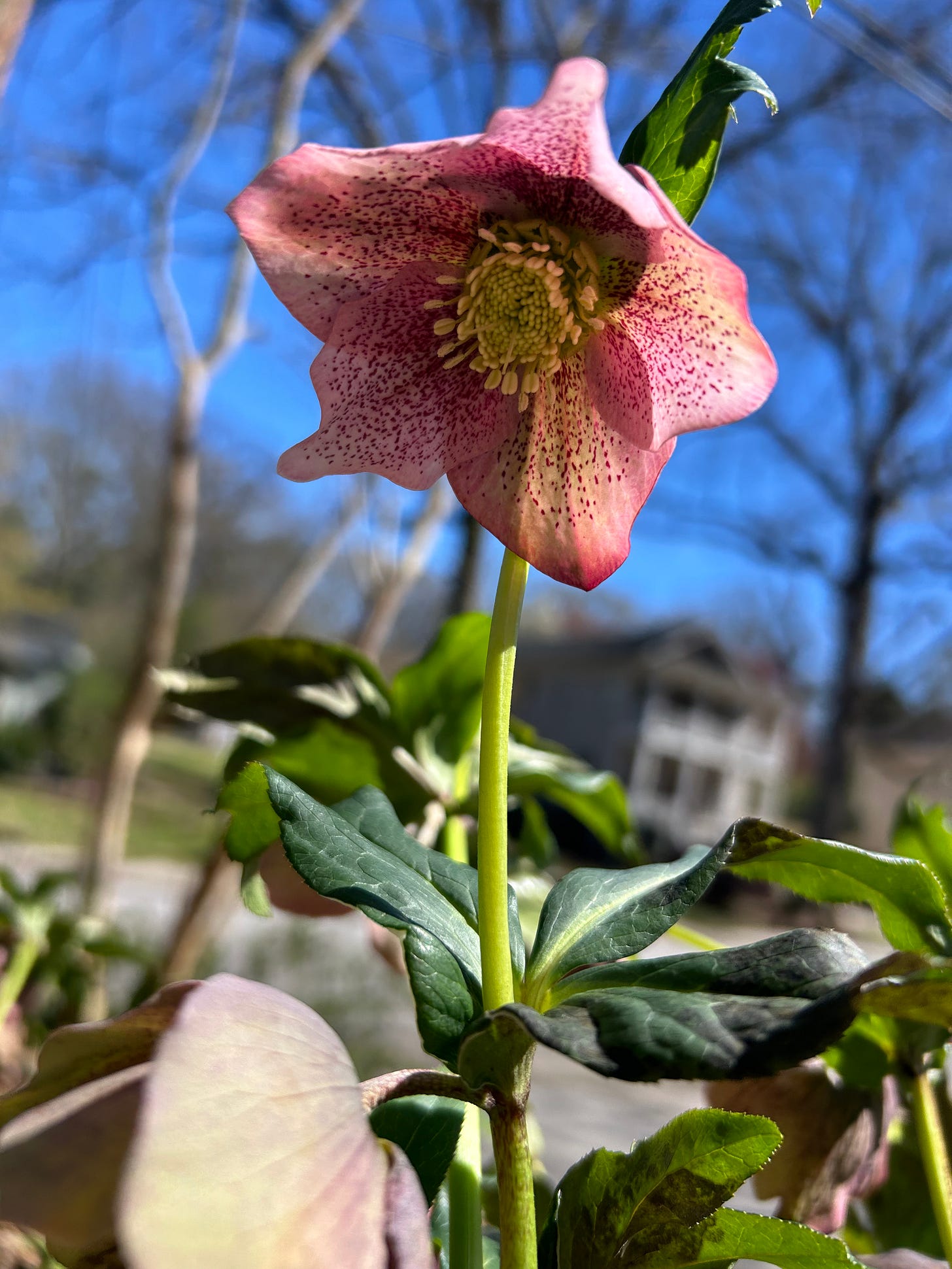The Unbearable Lightness of a Southern Winter
Fumbling our ragged, resilient way into spring.
Psst. Lean into me. Bring your ear close. Let’s keep this between us lovers of long shadows. The sun worshippers wouldn’t understand, bronzed and blithe, their dopamine fix dependent on perpetual sunshine. My secret is not for them, but for those among us who relish rainy days and long nights spent staring into the hollow hearts of bonfires. I bring my confession to you:
I am not ready for spring.
Don’t get me wrong, I go out daily to see what new bloom has appeared overnight: the bejeweled redbud branches, a spangle of dog violets like sudden purple confetti, hosta shoots pointing their fat fingers at a bluebird March sky. These are marvels that shouldn’t be squandered, even if you’re unprepared. Even if you’ve “lost an hour.” Even if you’re tired.
Here's the thing: in the deep south, we don’t really winter (in the
way of turning the season of rest and restoration into a concise verb.) Sure, we’ll have a hard, pipe-bursting freeze from time to time, or an unexpected snow day where manic children will fling themselves atop trash can lids and down hills dusted with icing sugar snow that melts within minutes.But the weather does not force us to stop—we don’t even have to consider it beyond gloves and a heavier coat. So, with bodily rhythms beating more to the 9-5 pulse of commerce or the alarm of an iPhone than the rise and fall of tree sap, we don’t. We treat winter like one, long overcast day. And when the hours of sunlight lengthen and the crocuses push through the soil, we, too, emerge blinking in the fresh brightness, utterly spent.
It's not just me. Friends, especially creative ones, stumble to the starting line of spring. Their thoughts had no season to ferment, their projects no time for gestation. Those who still speak with the soil mark the unsettling haste of spring’s arrival; the customary sigh of relief at surviving winter is replaced a gnawing anxiety at how short the season is growing, and how quickly.
In her recent post, “When February Feels Like May,” writer
notes: “Stitched through spring! beauty! bright flowers! the garden! greening! is the knowledge that February is the new May. We are in the wrong calendar month. I want to skip forward, the way I do when I can’t get my bank statement to balance, to accept the new figure and move on.”A friend with the unhurried patience possessed only by orchardists and saints listens to my apologetic bellyaching and reminds me that some seeds require the crucible of cold for dormancy. Without it, what might have blossomed into food, medicine, or an oak that could outlive us all, turns to mush.
Despite their small size, seeds contain elaborate archives filled with stories of place and relation written by their progenitors. Within this codex lies an arcane calculus for germination. In their native range, plants merely need to be seeded around the right time and the rugged hand of winter and the plant’s esoteric timetables will do the rest. They grow when they’re supposed to.
If, though, we want to cultivate a cold-weather plant outside its range or find ourselves late—or merely impatient—we can force nature to bend to our whims using our Frigidaires. Cold stratification allows us to grow plants from cooler climates or on a truncated timeline by mimicking the cold and damp with some paper towel in the back of the refrigerator.
What does a seed imprint from time spent in a crisper drawer instead of beneath the dark blanket of soil? Can it feel rushed? Or duped out of its well-deserved slumber. I know I stray a bit far, conjecturing about the sentient inner life of a seed. But the feverish world is warming at a pace that far outstrips any seed’s inborn sense of place or time. I imagine that, on some germinal level, the seeds, too, are feeling a little turned around.
Whatever wisdom I carry around inside the seed of myself might not be loud enough to slow me down during our mild winters, but something in there is coiled tight: a wound spring of apprehension, a waiting snake of worry. “The time is out of joint,” Hamlet laments after speaking to his father’s ghost. It certainly feels so. Compounding the background hum, animal panic of the warming world is the heartbreak of watching, if you choose not to turn away, incomprehensible cruelty on display for 150+ days.
Such barbarity both adds to and puts into stark perspective my comfortable pre-spring malaise. It also asks me to find reserves of focus and energy, to take what small, seemingly insignificant steps I can again and again, to push against a wall of darkness and hope it yields into a point of light from which something might grow.
Seeds know the merit of rest because they are built for resilience. Many require the adversity of frost, darkness, and rasping chipmunk teeth to sprout. If I am to believe that, like the minute punctuation of a primrose seed, I have a clock buried in my brain dedicated solely to rest and waiting, I must also accept that I carry within myself a fierce, stubborn hardiness.
Maybe what feels like falling apart as I near the spring equinox is merely an old husk wedging open. Maybe, despite my complaints, these are precisely the conditions I need to grow. But maybe, too, like the shy, freckled hellebore, I’ll incline my ear toward the earth a little while longer. We’re not quite done with our quiet, winter whispering.
Other Voices:
If the emergence of blooms earlier and earlier has you feeling ambivalent about spring’s arrival, here are some fantastic Substacks centering explorations of climate, place, and this splendid and imperiled place we call home:
- Australian renaissance woman believes that “We fight to save what we love. We need to be in nature, to return to our true nature, to be held and awed by it, to love it wildly. So that we will fight for it.” And that is the ethos at the heart of her fantastic newsletter that explores how to live in a way that is wild, that reminds us of what matters and that enables us to cope with what is ahead. - has been a fierce protector of the earth and its wild spaces all of her life. If you haven’t acquainted yourself with her Journey In Place, you’re missing out. In this year-long correspondence course in place-knowing, Ray guides you through reflections and exercises to deepen your intimacy and even brew up a little enchantment with the place you call home. - ’s newsletter provides accountability journalism for the climate crisis. She offers original reporting and analysis exposing and explaining “the forces behind past and present inaction on the most existential threat of our time”—and she welcomes your righteous indignation about what you discover. - When it comes to climate journalism, it doesn’t get more OG than , who describes his newsletter as “unfiltered communication, from me to you, about the deepest problem that humans have ever encountered.” McKibben’s passion and evocative writing make steeping yourself in some of the bleakest news as enjoyable as possible? (Just go read it.)








Your words ALWAYS speak to the deep places inside my soul. I thank you for that and I thank you for being you! ❤️
Your prose full of metaphors is so breath-taking and lovely. I love your observations on winter in the South, and your nod to other brilliant writers. Thank you for this beautiful reflection.